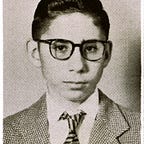Before I became a magazine photographer in Vancouver in 1977 I thought I was a purist when I shot b+w. I considered filters fakes. And this was the case until I understood the difference between the human eye and film (and video and digital) in relation to ultra violet. I discovered how John Ford had used deep red filters to get puffy clouds at “night” in his Westerns. Then sometime in the 80s I saw an article in the National Geographic that illustrated Stevenson’s grave in Samoa. The photographer had used a Cokin tobacco filter to make the sky pinker and darker at the top. I was apalled!
In my magazine photography the most important factor for me was the word justification. I had to justify to myself why I was doing what I was doing. In the late 80s I photographed Don Harron a Canadian CBC personality.
If you read this blog you will find out why I took out a dark green filter to make him look older. This is one of the few times where I ever made anybody look worse than they looked.
The idea of having more than one camera (I have many) is important if you dedicate one of them to b+w so when you pick it up you are forced to think black and white.
But there is something that photographers in this century should considere. Ansel Adams was a stickler to giving detail to his blacks without losing some sort of texture with the whites. In short, contrast has always been the enemy of photography. Human eyes can handle contrast better. In this century of extreme sharpness and saturation with colour we have forgotten the existence of the pastels, those soft colours found everywhere except perhaps in Instagram.
And finally, for years I had admired Edgerton’s photograph of the milk drop not knowing that the original was in colour. In the 80s I bought a book about the history of photography that had used a then revolutionary method for printing called four-colour. That’s when I discovered that the b+w photographs of the 19th century were rarely b+w. They were monochrome and many had shades of what we called split toning in the 20th century.
